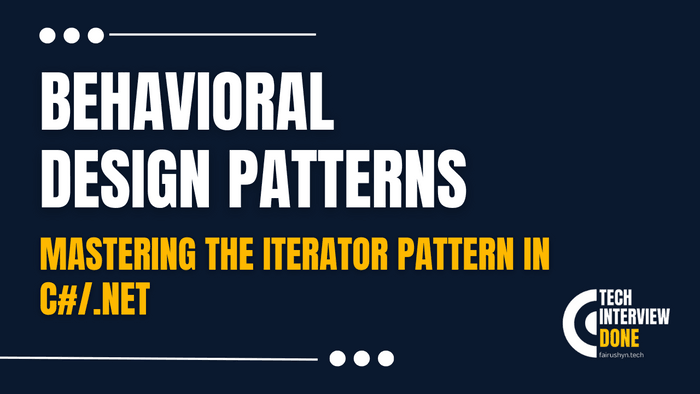Mastering the Iterator Pattern in C#/.NET
A Deep Dive for Experienced Software Engineers
3 min read · — #design-patterns#structrural-patterns#iterator
Introduction
Diving into the world of design patterns, the Iterator stands out as a foundational pillar, especially for those looking to fine-tune their craft in the C#/.NET landscape. This pattern, far from being just another academic concept, is a practical tool that simplifies complex data navigation, promotes cleaner code, and enhances maintainability. Its relevance spans from handling collections in memory to dealing with streams of data from external sources. As experienced software engineers, understanding and applying the Iterator pattern can significantly elevate our problem-solving toolkit, enabling us to tackle more complex challenges with elegance and efficiency.
Understanding the Iterator Pattern
The Iterator pattern falls under the category of behavioral design patterns, focusing on the ways objects interact and distribute responsibilities among themselves. Specifically, it provides a way to access the elements of an aggregate object sequentially without exposing its underlying representation. The pattern involves two key components:
- Iterator: An interface that defines the operations for accessing and traversing elements.
- ConcreteIterator: Implements the iterator interface and keeps track of the current position in the traversal.
In C#/.NET, the iterator pattern is beautifully integrated into the language and framework, making its implementation seamless and intuitive.
Real-world Scenario: Navigating a Social Media Feed
Consider the example of a social media application where you need to navigate through a user's feed. The feed consists of various types of content like posts, images, videos, etc., stored in a complex collection. Implementing the Iterator pattern allows you to abstract the complexity of traversing through these items, providing a simple interface to iterate over them, regardless of their underlying representation.
Implementation in C#/.NET
C# simplifies the implementation of the Iterator pattern through the use of IEnumerable and IEnumerator interfaces.
These are part of the .NET Framework's System.Collections namespace, serving as the backbone for iteration across
collections.
Defining the Aggregate Interface
First, you define an aggregate interface that returns an iterator. In our social media feed example, let's consider
an IFeed interface:
public interface IFeed
{
IIterator CreateIterator();
}Implementing the Concrete Aggregate
Next, you implement this interface in a concrete class, SocialMediaFeed, which represents a collection of social media
posts:
public class SocialMediaFeed : IFeed
{
private List<Post> _posts = new List<Post>();
public IIterator CreateIterator()
{
return new PostIterator(_posts);
}
public void AddPost(Post post)
{
_posts.Add(post);
}
}Defining the Iterator Interface
The IIterator interface declares methods for accessing and traversing elements:
public interface IIterator
{
bool HasNext();
object Next();
}Implementing the Concrete Iterator
The PostIterator implements the IIterator interface, managing the traversal over the social media posts:
public class PostIterator : IIterator
{
private readonly List<Post> _posts;
private int _current = 0;
public PostIterator(List<Post> posts)
{
_posts = posts;
}
public bool HasNext()
{
return _current < _posts.Count;
}
public object Next()
{
return HasNext() ? _posts[_current++] : null;
}
}Leveraging foreach and LINQ in C#
C#/.NET provides language-level support for iterators through foreach loops and LINQ queries, making it easier to work
with collections without implementing the pattern explicitly. When you use a foreach loop, the compiler automatically
uses the GetEnumerator method of the IEnumerable interface, which essentially follows the Iterator pattern.
Example: Using foreach with SocialMediaFeed
var feed = new SocialMediaFeed();
feed.AddPost(new Post("Hello, world!"));
feed.AddPost(new Post("Another post"));
foreach (var post in feed)
{
Console.WriteLine(post.Content);
}This approach abstracts the iterator logic, allowing developers to focus on business logic rather than the intricacies of collection traversal.
Conclusion
The Iterator pattern is a powerful tool in the C#/.NET ecosystem, offering a standardized approach to navigating collections. By abstracting the traversal logic, it not only makes our code more readable and maintainable but also leverages the rich features of C# to simplify implementation. Whether you're dealing with in-memory collections or streaming data from external sources, mastering the Iterator pattern can significantly enhance your coding toolkit, enabling you to write elegant and efficient applications. As you prepare for your technical interviews or look to deepen your understanding of design patterns, consider the Iterator pattern as a critical component of your software engineering arsenal.
